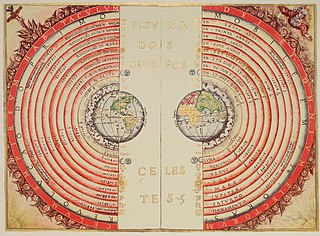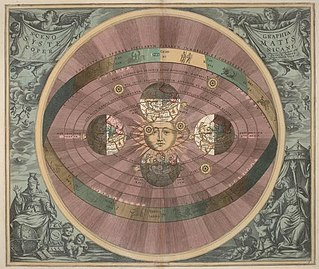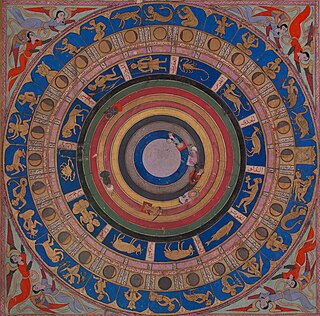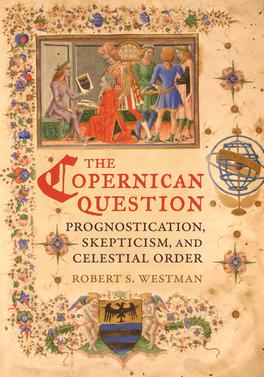
A horoscope is an astrological chart or diagram representing the positions of the Sun, Moon, planets, astrological aspects and sensitive angles at the time of an event, such as the moment of a person's birth. The word horoscope is derived from the Greek words ōra and scopos meaning "time" and "observer". It is claimed by proponents of astrology that a horoscope can be used as a method of divination regarding events relating to the point in time it represents, and it forms the basis of the horoscopic traditions of astrology, although practices surrounding astrology have been recognized as pseudoscientific since the 18th century. Horoscope columns are often featured in print and online newspapers.

In astronomy, the geocentric model is a superseded description of the Universe with Earth at the center. Under most geocentric models, the Sun, Moon, stars, and planets all orbit Earth. The geocentric model was the predominant description of the cosmos in many European ancient civilizations, such as those of Aristotle in Classical Greece and Ptolemy in Roman Egypt.

In the Hipparchian, Ptolemaic, and Copernican systems of astronomy, the epicycle was a geometric model used to explain the variations in speed and direction of the apparent motion of the Moon, Sun, and planets. In particular it explained the apparent retrograde motion of the five planets known at the time. Secondarily, it also explained changes in the apparent distances of the planets from the Earth.

Western astrology is the system of astrology most popular in Western countries. Western astrology is historically based on Ptolemy's Tetrabiblos, which in turn was a continuation of Hellenistic and ultimately Babylonian traditions.

Most horoscopic traditions of astrology systems divide the horoscope into a number of houses whose positions depend on time and location rather than on date. In Hindu astrological tradition these are known as Bhāvas. The houses of the horoscope represent different fields of experience wherein the energies of the signs and planets operate—described in terms of physical surroundings as well as personal life experiences.

The ascendant or rising sign is the astrological sign on the eastern horizon when the person was born. It signifies a person's physical appearance, and awakening consciousness.

Heliocentrism is the astronomical model in which the Earth and planets revolve around the Sun at the center of the universe. Historically, heliocentrism was opposed to geocentrism, which placed the Earth at the center. The notion that the Earth revolves around the Sun had been proposed as early as the third century BC by Aristarchus of Samos, who had been influenced by a concept presented by Philolaus of Croton. In the 5th century BC the Greek Philosophers Philolaus and Hicetas had the thought on different occasions that the Earth was spherical and revolving around a "mystical" central fire, and that this fire regulated the universe. In medieval Europe, however, Aristarchus' heliocentrism attracted little attention—possibly because of the loss of scientific works of the Hellenistic period.

Astrology and astronomy were archaically treated together, but gradually distinguished through the Late Middle Ages into the Age of Reason. Developments in 17th century philosophy resulted in astrology and astronomy operating as independent pursuits by the 18th century.

Natal astrology is also known as Genethliacal Astrology, which implies nativity. It is a system of astrology that claims to shed light on an individual’s personality or path in life. This concept is based on constructing a horoscope or natal chart that includes the exact date, time, and location of an individual's birth. Natal astrology is found in the Indian or Jyotisha, Chinese and Western astrological traditions.

Some medieval Muslims took a keen interest in the study of astrology, despite the Islamic prohibitions partly because they considered the celestial bodies to be essential, partly because the dwellers of desert-regions often travelled at night, and relied upon knowledge of the constellations for guidance in their journeys. After the advent of Islam, the Muslims needed to determine the time of the prayers, the direction of the Kaaba, and the correct orientation of the mosque, all of which helped give a religious impetus to the study of astronomy and contributed towards the belief that the heavenly bodies were influential upon terrestrial affairs as well as the human condition. The science dealing with such influences was termed astrology, a discipline contained within the field of astronomy. The principles of these studies were rooted in Arabian, Persian, Babylonian, Hellenistic and Indian traditions and both were developed by the Arabs following their establishment of a magnificent observatory and library of astronomical and astrological texts at Baghdad in the 8th century.

Copernican heliocentrism is the astronomical model developed by Nicolaus Copernicus and published in 1543. This model positioned the Sun at the center of the Universe, motionless, with Earth and the other planets orbiting around it in circular paths, modified by epicycles, and at uniform speeds. The Copernican model displaced the geocentric model of Ptolemy that had prevailed for centuries, which had placed Earth at the center of the Universe.

Astrological progressions are one of the main means used in Horoscopic astrology to forecast future trends and developments. As its name implies, astrological progression involves a method of progressing the Horoscope forward from the moment of the birth or beginning of the subject into the future, and is most usually done for the birth or natal chart of a particular individual.

Paul Wittich was a German mathematician and astronomer whose Capellan geoheliocentric model, in which the inner planets Mercury and Venus orbit the Sun but the outer planets Mars, Jupiter and Saturn orbit the Earth, may have directly inspired Tycho Brahe's more radically heliocentric geoheliocentric model in which all the 5 known primary planets orbited the Sun, which in turn orbited the stationary Earth.

The center of the Universe is a concept that lacks a coherent definition in modern astronomy; according to standard cosmological theories on the shape of the universe, it has no center.
Joshua Childrey (1623–1670) was an English churchman and academic, antiquary and astrologer, the archdeacon of Salisbury from 1664. He was a "country virtuoso", and an avowed Baconian. He also has been considered a dilettante.

The Copernican Question: Prognostication, Skepticism, and Celestial Order is a 704-page book written by Robert S. Westman and published by University of California Press in 2011 and in 2020 (paperback). The book is a broad historical overview of Europe's astronomical and astrological culture leading to Copernicus’s De revolutionibus and follows the scholarly debates that took place roughly over three generations after Copernicus.

The historical models of the Solar System began during prehistoric periods and are updated to this day. The models of the Solar System throughout history were first represented in the early form of cave markings and drawings, calendars and astronomical symbols. Then books and written records became the main source of information that expressed the way the people of the time thought of the Solar System.
The Wittenberg Interpretation refers to the work of astronomers and mathematicians at the University of Wittenberg in response to the heliocentric model of the Solar System proposed by Nicholas Copernicus, in his 1543 book De revolutionibus orbium coelestium. The Wittenberg Interpretation fostered an acceptance of the heliocentric model and had a part in beginning the Scientific Revolution.










